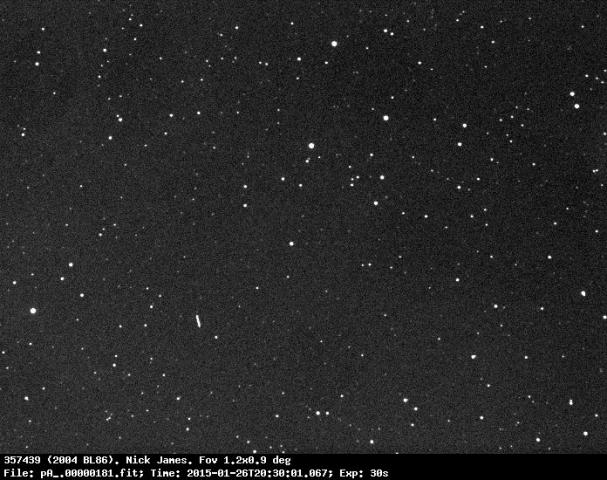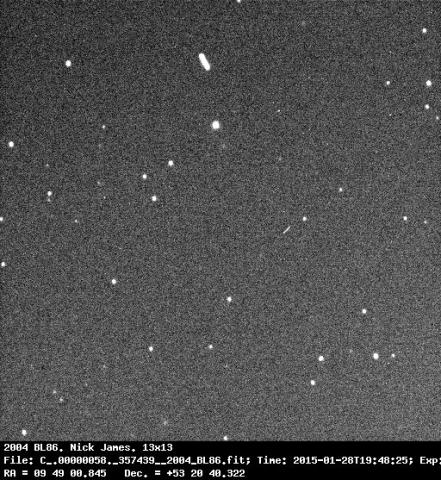- This topic has 10 replies, 6 voices, and was last updated 10 years, 11 months ago by
 Richard Miles.
Richard Miles.
-
AuthorPosts
-
26 January 2015 at 8:31 pm #573415
 Nick JamesParticipant
Nick JamesParticipantWeather is good in Chelmsford at the moment. You can watch the flyby live here. I’ve just seen it visually in a 6-inch SCT. Hope others are getting a good view too.

Attachments:
26 January 2015 at 8:57 pm #576781 Gary PoynerParticipant
Gary PoynerParticipantCloudy here in Birmingham Nick, so nice to see it in clear Essex skies!
Gary
27 January 2015 at 8:06 am #576782 Nick JamesParticipant
Nick JamesParticipantThanks Gary. Here’s an animation from some of the frames.
27 January 2015 at 2:32 pm #576783 Gary PoynerParticipant
Gary PoynerParticipantNice one. Thanks Nick!
Gary
27 January 2015 at 8:03 pm #576784 Peter CarsonParticipantThe cloud held off until the early hours of this morning here in SE Essex. I managed a series of visual sightings through my 315mm reflector from early evening up to just after midnight. I’ve also imaged several sequences of 2004BL86 crossing the 36’x27′ field of view. See my animation from just after midnight here http://youtu.be/ORPvj–5WDw Detail of the timelapse are on the Youtube page.Peter28 January 2015 at 7:50 am #576785
Peter CarsonParticipantThe cloud held off until the early hours of this morning here in SE Essex. I managed a series of visual sightings through my 315mm reflector from early evening up to just after midnight. I’ve also imaged several sequences of 2004BL86 crossing the 36’x27′ field of view. See my animation from just after midnight here http://youtu.be/ORPvj–5WDw Detail of the timelapse are on the Youtube page.Peter28 January 2015 at 7:50 am #576785 Nick JamesParticipant
Nick JamesParticipantPeter,
Good to see your results too. I think we were very lucky with the weather for this event. Hopefully we should be able to extract a good light curve from all of this data.
Nick.
28 January 2015 at 3:48 pm #576786Fogged up in Bournemouth but great shots in Essex.
I have found any easy way to place the asteriod in SKY X and this may be available in other software planeterian software.
The path is input; small solar system bodies; asteriods small data base; name. Paste the name and OK results in download from the web. Rather easier than the route via the minor planet centre.
28 January 2015 at 7:54 pm #576787 Nick JamesParticipant
Nick JamesParticipantIt’s still visible tonight around 12th mag and moving much more slowly.
Nick
 7 February 2015 at 1:01 pm #576788
7 February 2015 at 1:01 pm #576788 Mike FoylanParticipant
Mike FoylanParticipantHi Guys
Really excellent work and excellent images, thanks for posting. Clouded out here unfortunately at the time. Just wondering if there was a rotation period reported for 2004 BL86?
I checked the Minor Planet Ephemeris Service for this object and it reported that its apparent motion across the sky was in the order of 159 arcsec/min around closest flyby. A quick calculation for my own telescope system with a pixel scale of 2.17 arcsec/pixel indicates that a maximum exposure time of 0.8 seconds was allowable before trailing would occur of the asteroid target! I think this would indeed be a big challenge to obtain good SNR values and even more so for a rotation curve! I am guessing that those in possession of higher end tracking mounts can somehow program the mount to follow the asteroid instead of sidereal rate.Best wishes and clear skies
Mike8 February 2015 at 9:51 am #576789 Nick JamesParticipant
Nick JamesParticipantMike,
I think the adopted rotation period is 2.6 hrs with a lightcure amplitude of around 0.2 mags. That means that I should have two rotations on the image set that I took on close approach night but I haven’t managed to find the time to do the initial analysis yet. Richard Miles has been helping me with the details and we hope to have something soon. The lightcurve may even show the effects of the small moon. Keep an eye on the ARPS page for more info.
You’re right that the motion was fast but the asteroid was so bright it was detectable with small instruments. Most of my images were made using a 72mm f/6 WO Megrez refractor and CCD tracked at sidereal rate. The wide field makes photometric reduction easier since there are lots of suitable reference stars visible.
Nick.
8 February 2015 at 11:56 am #576790 Richard MilesParticipant
Richard MilesParticipantFurther to what Nick has added, I have now received 23 reports from observers. Sky conditions in the UK did not lend themselves to photometry. Nick should have the best sequence but hopefully once he has measured his hundreds of frames I can add data from other observers. Roger Drew obtained a nice sequence as it skirted the edge of the open cluster Praesepe (Messier 44) in Cancer for instance – that occurred at around 5.00-6.00 am so it was a fine effort on his part to obtain high-quality data at that time. Soon to appear on the ARPS web pages …
Richard
-
AuthorPosts
- You must be logged in to reply to this topic.
